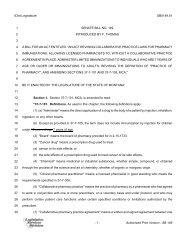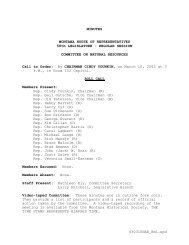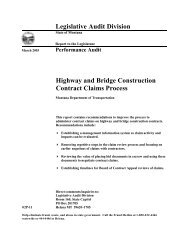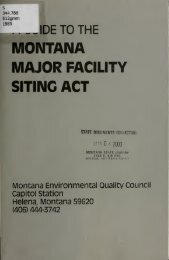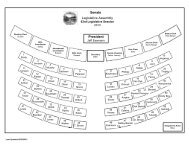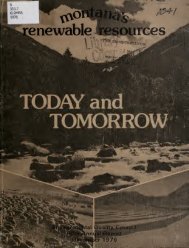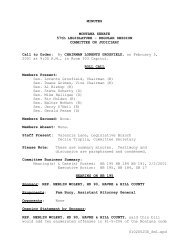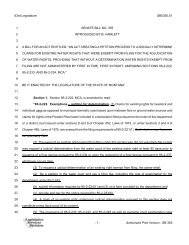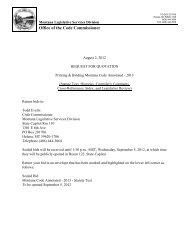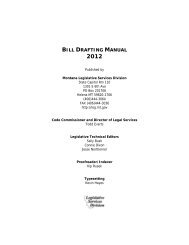Public Comment. Volume III - Montana Legislature
Public Comment. Volume III - Montana Legislature
Public Comment. Volume III - Montana Legislature
Create successful ePaper yourself
Turn your PDF publications into a flip-book with our unique Google optimized e-Paper software.
ights-of-way along with other uses, such as<br />
livestock grazing, fish and wildlife habitat,<br />
mineral extraction, timber harvesting,<br />
recreation, and other activities.<br />
Coals of the Right-of-way Program<br />
The BLM right-of-way<br />
designed to:<br />
Coordinate the actions of individuals,<br />
government, and business.<br />
F'romote the sharing of rights-of-way.<br />
F'rotect the quality of our Nation's '<br />
land resources.<br />
F'revent unnecessary environmental<br />
damage to lands and resources.<br />
Protect the holder's investments in<br />
improvements on the right-of-way.<br />
When You Do--and When<br />
You Don't--Need a Right-of-way<br />
As a general rule, you do need a right-of-way<br />
whenever you wish to build a project on the<br />
public lands. A list of examples is printed below.<br />
You don't need a right-of-way for so-called<br />
"casual use." What kinds of activities are considered<br />
"casual use"? Examples include driving<br />
vehicles over existing roads, sampling, surveying,<br />
marking routes, traveling on existing roads to<br />
private property, collecting data to prepare an<br />
application for a right-of-way, and performing<br />
certain activities that do not unduly disturb the<br />
surface or require extensive removal of vegetation.<br />
Depending on the specifics of your proposed<br />
activity, some right-of-way uses on the public<br />
lands can be either casual use or use requiring a<br />
grant. It's a good idea to contact the BLM and<br />
discuss your plans before assuming your use is<br />
casual. The Area Manager can then make a<br />
judgment on the requirements in your particular<br />
case.<br />
is<br />
Typical Land Uses<br />
Requiring Right-of-way Grants<br />
Here are some examples of land uses requiring<br />
right-of-way grants, which must be obtained<br />
: before construction of any kind may begin.<br />
Water-Related Systems<br />
canals ditches<br />
flumes laterals<br />
pipes pipelines<br />
reservoirs tunnels<br />
Oil and Gas and Related Systems<br />
conveyor belts<br />
pipelines<br />
storage facilities<br />
Electrical Generation, Transmission, and<br />
Distribution Systems<br />
biomass coal<br />
gas hydro<br />
nuclear oil<br />
solar wind<br />
Transmission and Reception Systems<br />
microwave radio .<br />
telegraph telephone<br />
television other electronics<br />
Transportation Systems<br />
airways canals<br />
highways roads<br />
trails tramways<br />
tunnels<br />
Steps in Applying for a Right-of-way<br />
1. Contact the BLM office with management<br />
responsibility for the land where the right-of-way<br />
is needed.<br />
2. Arrange a preapplication meeting with the<br />
Area Manager or appropriate staff member.<br />
Jointly review the application requirements and<br />
form to determine what information is needed.<br />
3<br />
-1 62- <strong>Volume</strong> Ill: <strong>Public</strong> <strong>Comment</strong>



